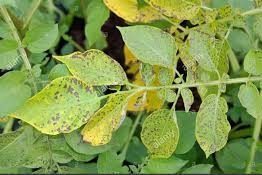Blight on Tomatoes and Potatoes
Potato and tomato blight is a disease caused by a fungus-like organism that spreads rapidly in the foliage and tubers or fruit of potatoes and tomatoes in wet weather, causing collapse and decay.
It is a serious disease for potatoes and outdoor tomatoes, but not as common on tomatoes grown in greenhouses.
Blight is specific to tomatoes, potatoes and some ornamental relatives of these two crops. Cases have been recorded on ornamental Solanum species (e.g. S. laciniatum), and also on Petunia.
You may see the following symptoms:
Potatoes
- The initial symptom of blight on potatoes is a rapidly spreading, watery rot of leaves which soon collapse, shrivel and turn brown. During humid conditions, a fine white fungal growth may be seen around the edge of the lesions on the underside of the leaves
- Brown lesions may develop on the stems
- If allowed to spread unchecked, the disease will reach the tubers. Affected tubers have a reddish-brown decay below the skin, firm at first but soon developing into a soft rot as the tissues are invaded by bacteria. Early attacks of blight may not be visible on tubers, but any infected tubers will rot in store
Tomatoes
- The symptoms on tomato leaves and stems are similar to those on potatoes
- Brown patches may appear on green fruit, while more mature fruits will decay rapidly
Non-chemical control
- Infected material should be deeply buried (more than 45cm deep), consigned to the green waste collection or, ideally, burned rather than composted
- Earthing up potatoes provides some protection to tubers
- Early-harvested potatoes are more likely to escape infection
- Gardeners are able to access forecast warnings of when blight is active, or when there have been confirmed cases, in their region (visit the Fight Against Blight website),
- Picking off leaves or leaflets when just a few are affected may slow down the progress of the disease very slightly, but will not eradicate the problem
- When infection levels reach about 25 percent of leaves affected or marks appear on stems cut off the foliage (haulm), severing the stalks near soil level and raking up debris. When the skin on tubers has hardened, after about two weeks, the tubers can be dug up. To prevent slug damage avoid leaving tubers in the soil after this time
- Use the tubers from blighted crops as soon as possible, checking any stored tubers regularly for decay
- Operate a rotation to reduce the risk of infection, ideally of at least four years
- Destroy all potatoes left in the soil, and any waste from storage, before the following spring
The genetic population of the fungus is ever changing and new findings have shown that one dominant new strain seems to have overcome major gene resistance. Some old favourites are very susceptible, eg ‘Arran Pilot’, ‘King Edward’, ‘Majestic’, ‘Sharpe’s Express’.
The AHDB have a website where you can search for different potato varieties and see what resistance they have to pests and diseases including blight.
Click here for the Potato Variety Database.
Tomatoes are generally very susceptible, but the varieties ‘Defiant’, ‘Crimson Crush’, ‘Ferline’, ‘Legend’ and ‘Fantasio’ show varying resistance to blight. Even these varieties, however, will eventually succumb in wet, warm weather. It is probably best not to rely on host resistance for blight control in tomatoes.
Chemical control
There are currently no fungicides available for use by gardeners against blight on potatoes or tomatoes.
The late blight pathogen is a microscopic, fungus-like organism whose sporangia (spore-bearing structures) easily break away from infected foliage and may be wind-blown for long distances. The actual infective spores are released from the sporangia into water and need to swim in a water film before settling on the plant surface and penetrating into leaf tissues; this is why the disease is so serious in wet summers. The pathogen then spreads rapidly, killing the cells. Under humid conditions, stalks bearing sporangia grow from freshly killed tissues and the disease can spread rapidly through the crop.
The pathogen overwinters in rotten potatoes left in the ground or by the sides of fields. However, the great majority of infections in gardens arise from wind-blown sporangia originating in other gardens, allotments and commercial crops. In the UK, outbreaks may occur from June onwards, usually earliest in the South West.
The presence of new strains in the UK means that the pathogen now has the potential to produce resting spores (oospores) in the affected plant tissues. The oospores are released from the rotting tissues to contaminate the soil. These resting spores have yet to be found in the UK, however, and little is currently known about their survival and their potential as a source of the disease. The investigations into oospores are continuing and more information may be available in a few years.
Late attacks of blight defoliate potato crops, but if the disease arrives after the tubers are set and they are harvested before they become infected, little is lost. However early attacks can also be devastating and blight is the most important commercial disease of potatoes. Outdoor tomatoes are at high risk of infection if the weather is suitable. The disease is less of a problem under glass as the spores have to find their way into the glasshouse through doors and vents. If, however, blight establishes in a glasshouse the high humidity inside usually leads to very rapid development of symptoms.
Article courtesy of rhs.org.uk

